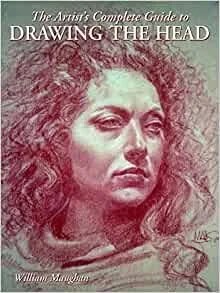The Artist’s Complete Guide To Drawing The Head by William L. Maughan (book review).
I’ve been keeping ‘The Artist’s Complete Guide To Drawing The Head’ by William L. Maughan in my shopping list for some time but finding a couple artbooks in my pile weren’t covering information foe pastels in my pile finally decided my buying a copy of this 2004 book.
Maughan’s technique is to build out from chiaroscuro, that is lay down the shadow aspects first and then put the details in, adding white for reflective light. I can draw (sic) comparisons to painting when you do an under-painting to get the colouring right before building the detail up on that. You’re also going to need to sharpen your pastel pencils with inch-long points although you will be suing them on their flat edge to make the most of the line.
Although Maughan uses a knife to sharpen his pastels although I use conte, they do have a habit of breaking too easily and am investigating some of the sharpeners out there that will make longer and if the core breaks I can keep going. The point I’m making, there are a lot more choices out there than just using a knife, although I did use a knife to get my long pointed pastels.
Interestingly, Maughan is also an Andrew Loomis fan, although oddly, he points to ‘Creative Illustration’ than his ‘Drawing The Head And Hands’ book.
One thing he does that I’m an advocate for is showing drawing mistakes although I think there does need to be a means to show just how big the differences are, as with the lips to the nose to the chin. Often its as matter of a fraction of an inch difference and its only practice and observation that gets it right. The non-artist will know something isn’t quite right, the artist has to know why.
What I found most important is getting the important lines right and what to focus on. Using doughnut shapes around the lips to build up the shape is useful to remember. Equally, the outline benefits from this and you have a bit of a bump there rather than a straight line. No profile is straight of a curve, so its always important to study this when inspecting photographs.
What does make this book especially important for our genre is Maughan doing chimeras of human and animals with various expressions, showing the same drawing rules apply. We generally see fantasy/SF artists staying within their techniques, rarely with ‘normal’ artists going in the opposite direction and this was the biggest surprise of this book.
To end the book, Maughan applies his technique to colour in both pastels and paint so you get an all-round useful textbook. Even if you’re a good artist, then you’ll pick up some reminders to sharpen up your techniques which is always a good reason to add another how-to artbook to your collection. An odd effect after completing this book, I was looking at photographs with my head turned on to its dark and light so was in automatic study mode. If you can come away from this book with a similar effect then proceed to draw because it might have sunk into your head.
Just to show I do know how to draw, I’ve included a picture I drew based on Maughan’s guidelines. The original was drawn on an A4 toothed page not relying on anymore than a couple marks for top of head, chin and shoulders before building outline, eye marker and then build-up. I think the page tooth was still a bit rough but at least the final picture should be recognisable when shrunk to about an inch and I ought to do the eyes a bit finer next time.

GF Willmetts
June 2022
(pub: Watson-Guptil, 2004. 160 page illustrated softcover. Price: ISBN: 978-0-82300359-4)
check out website: https://crownpublishing.com/archives/imprint/watson-guptill

